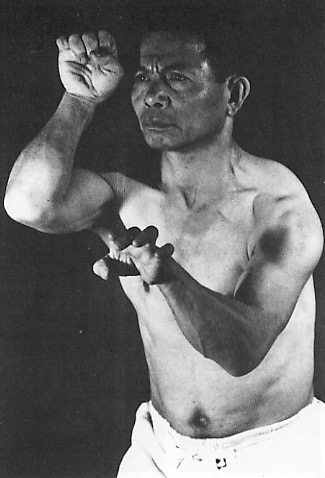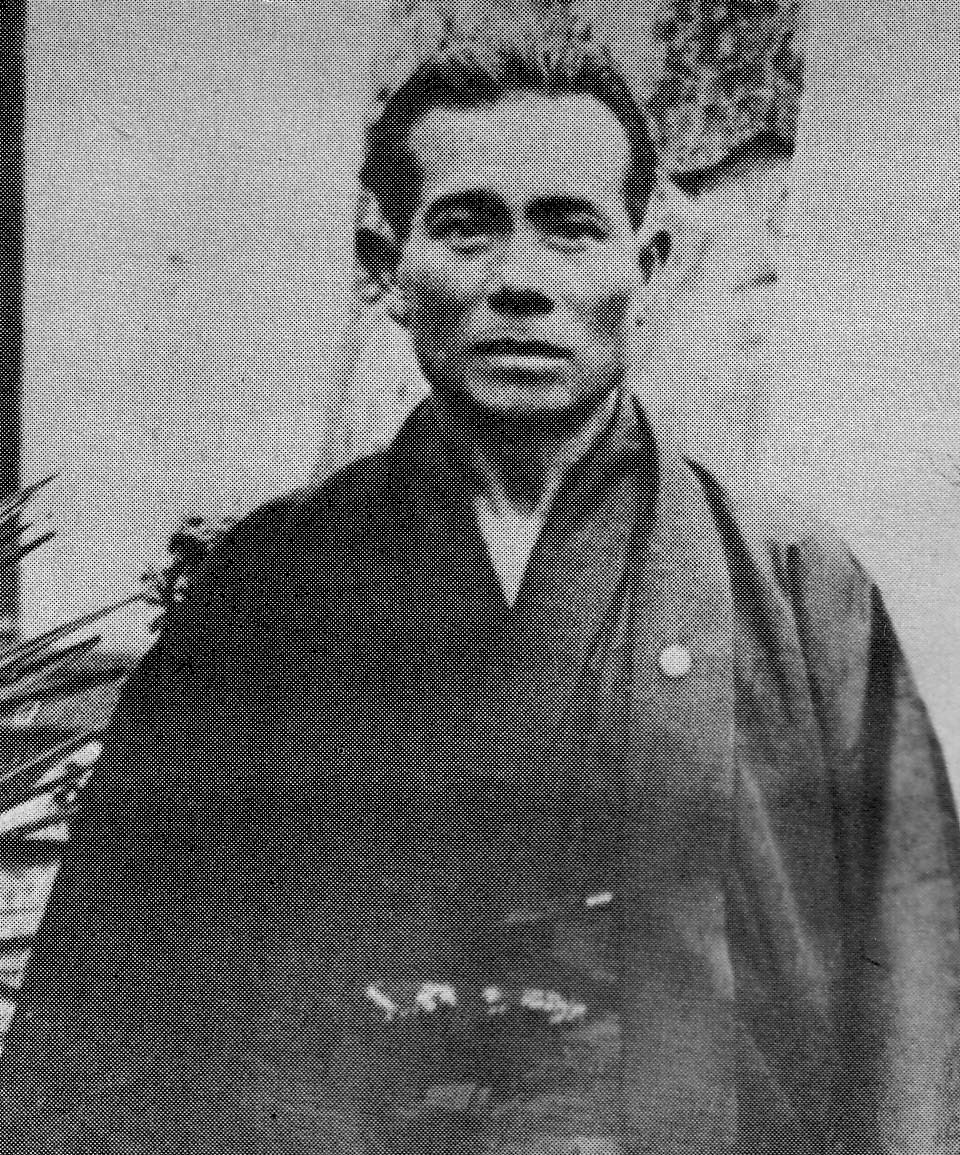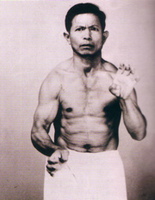“The Monarch of Uechi Ryu” Please share with a friend

Kanbun Uechi 1877 – 1948
“The Monarch of Uechi Ryu”


Kanbun Uechi was the founder of Uechi-ryū, one of the primary karate styles of Okinawa. He was born in Izumi Village, Motobu Peninsula, Northern Okinawa, the eldest son of a samurai family.
 At the age of 19, Kanbun
fled to Fuzhou in Fukien
Province, China to escape Japanese
military conscription and to fulfill his dreams of studying martial arts with
Chinese masters. Upon arrival, Uechi who
had a speech impediment initially took up the study of Kojo Ryū, but soon changed, after his speech
was mocked, to the study of herbalism and a Kung Fu system called "Pangai-noon" kempo (or Pangainun), under a Chinese master named
Shushiwa. In 1904, after ten years of
training, Uechi received a certificate of mastery and was allowed to teach Pan
Gai Noon in Nanching (Nansoye), where he opened his own dojo. Three years later one of his students killed
a man during a land dispute, and Uechi was forced to close the school feeling
responsible in part for the death. This
ended Kanbun Uechi’s life in China. In
February 1910, he returned home to Izumi, Okinawa, to farm, vowing never to
teach quan’fa again, though many sought him out.
At the age of 19, Kanbun
fled to Fuzhou in Fukien
Province, China to escape Japanese
military conscription and to fulfill his dreams of studying martial arts with
Chinese masters. Upon arrival, Uechi who
had a speech impediment initially took up the study of Kojo Ryū, but soon changed, after his speech
was mocked, to the study of herbalism and a Kung Fu system called "Pangai-noon" kempo (or Pangainun), under a Chinese master named
Shushiwa. In 1904, after ten years of
training, Uechi received a certificate of mastery and was allowed to teach Pan
Gai Noon in Nanching (Nansoye), where he opened his own dojo. Three years later one of his students killed
a man during a land dispute, and Uechi was forced to close the school feeling
responsible in part for the death. This
ended Kanbun Uechi’s life in China. In
February 1910, he returned home to Izumi, Okinawa, to farm, vowing never to
teach quan’fa again, though many sought him out.
In 1924, Uechi was forced to seek employment in Wakayama City, Wakayama Prefecture, mainland Japan, where in 1925, he married and raised four children. As well he established the Institute of "Pangainun-ryu (half-hard and soft) Todi-jutsu", and began launching his own dojo. Uechi continued to teach in Wakayama until his death November 25,1948.
The style he taught, named Pan gai Noon Karate Jutso, was later renamed in his honour in 1940 to "Uechi-Ryū" Karate. It was greatly systematized by Kanei. In 1942 the Okinawan Ryuko Tomoyose built a Dojo for Kanei in Ginowan, Okinawa. It later became the Honbu Dojo of Uechi-Ryu.
 Uechi’s martial studies are documented up to the time he left
the Kojo dojo. Oral tradition holds that
Uechi eventually became the student of Zho Zhi He, commonly referred to in
Japanese as Shu Shi Wa. Further that
this master was an enigmatic figure about whom there is little written
history. It is known that Uechi
furthered his studies of Chinese boxing with Zho Zhi/ShuShiWa. What emerges with more than a ring of truth,
is that after Kanbun left the Kojo dojo he entered what is described as a
central Buddhist temple in Fujian/Fuzhou, and was introduced to Zho, reportedly
the 36th generation head of the temple. It is known that Zho/Shu Shi Wa originated from Minhou, Fujian, was a civil
boxing teacher, studied martial arts
under Li Zhao Bei and Ke Xi Di, and was proficient in a variety of
quan’fa. Zho practiced Crane and Tiger boxing, in addition
to hard and soft qi gong, and was noted for his iron palm technique. Given the close traditional relationship
between master and student, there is every reason to accept that Uechi learned
and profited from the diverse skills and competencies taught by Zho/Shu Shi Wa
within the strict realities of the dojo.
Uechi’s martial studies are documented up to the time he left
the Kojo dojo. Oral tradition holds that
Uechi eventually became the student of Zho Zhi He, commonly referred to in
Japanese as Shu Shi Wa. Further that
this master was an enigmatic figure about whom there is little written
history. It is known that Uechi
furthered his studies of Chinese boxing with Zho Zhi/ShuShiWa. What emerges with more than a ring of truth,
is that after Kanbun left the Kojo dojo he entered what is described as a
central Buddhist temple in Fujian/Fuzhou, and was introduced to Zho, reportedly
the 36th generation head of the temple. It is known that Zho/Shu Shi Wa originated from Minhou, Fujian, was a civil
boxing teacher, studied martial arts
under Li Zhao Bei and Ke Xi Di, and was proficient in a variety of
quan’fa. Zho practiced Crane and Tiger boxing, in addition
to hard and soft qi gong, and was noted for his iron palm technique. Given the close traditional relationship
between master and student, there is every reason to accept that Uechi learned
and profited from the diverse skills and competencies taught by Zho/Shu Shi Wa
within the strict realities of the dojo.
Compared to oral tradition, there is a dearth of written information on the history, training methods and philosophy of Uechi-ryu Karate for English speaking practitioners. This has been remedied in part by pioneering works by Uechi’s senior student George Matteson: The Way of Karate (1963) and Uechi-ryu Karate-do (1974), and by Alan Dollar (1966) Secrets of Uechi-ryu Karate and the Mysteries of Okinawa.
Uechi Ryu Karate is distinguished as a powerful, hard Okinawan style, originating in China, and brought to Okinawa and Japan early in this century by Kanbun Uechi. It shares similarities with Goju Ryu karate and the lesser Naha-Te styles of To’on Ryu and Ryuei Ryu. Characterized by upright stances, circular blocks, grabs, open hand and one-knuckle techniques, plus low kicking, often using the big toe, Uechi Ryu incorporates the xing/kata: sanchin, seisan, sanseiryu as well as koketitae (arm pounding conditioning) and sophisticated push-hand and trapping flow drill.
It enjoys a large following in Okinawa, Japan, worldwide, and in particular the north- eastern United States where there are many dojos with strong links to George Matteson, Grand Master Kanbun, and the legendary committed martial artists ‘who have gone before’ in the shared history of China, Japan, and Okinawa.
